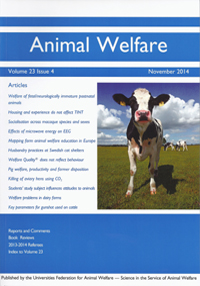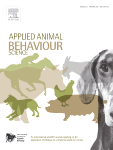Document type : Scientific article published in Animal Welfare
Authors: N. Volkmann, J. Stracke, S.L. Rauterberg, B. Spindler, N. Kemper
Preview: In Europe, conventional housing systems for finishing bulls (Bos taurus) tend to consist of group pens with a high stocking density. Up until now there have been no regulations in place defining bulls' space requirements, even although insufficient space allowance is considered to impair animal welfare. Our study aimed to measure the surface area that finishing bulls occupy in standing and lying positions. We observed 46 bulls on a German fattening farm. The animals from one pen were assigned to one of three weight classes (W1: < 450 kg; W2: 450-649 kg; W3: ≥ 650 kg), and two pens of each weight class were examined. For image recordings, a camera trap was installed above the pens. To analyse the covered surface, the recorded images (n = 242) were edited. Furthermore, the observed lying postures were differentiated in terms of lying position and stretched-out legs. On average, the areas covered by the bulls increased with class of bodyweight. A finishing bull covered up to 1.21 m2 in a standing position and up to 1.57 m2 in a lying position, the most space being needed in an outstretched position. The calculated values provide information only about the surface a finishing bull covered in different positions in the pen. In practice, additional dynamic and social space must be taken into account for recommendations on space requirements, in order to ensure adequate inter-individual distances, social interaction and characteristic behaviours to improve animal welfare.






